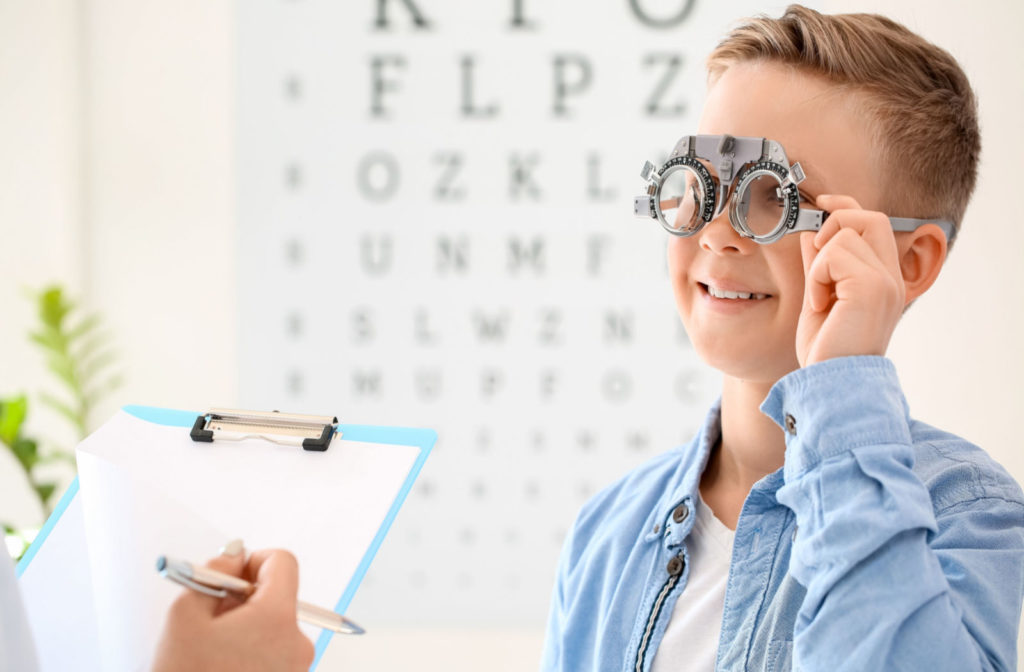Vision and learning go hand in hand. If your child can’t see their teacher, classmates, and the board with clarity, they aren’t able to reach their full academic potential.
Visiting your trusted optometrist every year can detect signs of vision issues and determine if your child needs glasses, contact lenses, or further visual intervention such as myopia control.
As your child grows and develops, so do their eyes. Helping your child succeed in the classroom starts with a comprehensive eye exam.
How Does Vision Relate to Learning?
Sight is our leading sense of gathering information. In fact, 60% of the brain is used for receiving, deciphering, and interpreting information from our eyes, and 80% of learning is visual.
Reading, writing, spelling, and memorization can all be impacted if your child struggles with a vision-related learning problem. Knowing the signs and booking annual eye exams are crucial to protecting your child’s vision.
Sign Your Child Is Struggling with a Vision-Related Learning Problem
If you notice your child is having difficulties at school, monitor for the following signs that could indicate they’re experiencing a vision-related learning problem:
- Holding reading materials close to their face
- Tilting their head or closing an eye while reading
- Losing their place while reading
- Complaints of headaches
- Issues with hand-eye coordination
- Avoiding close-up work like reading or writing
- Rubbing their eyes often
- Excessive blinking
Young children may also not complain of vision problems or show signs of issues because they might not have a frame of reference to what normal vision looks and feels like. Even if you don’t see any signs your child is struggling with a vision problem, it’s still important to schedule an eye exam every year to catch what isn’t outwardly noticeable.
Vision-Related Learning Difficulties
Functional Vision Problems
Functional vision refers to how your child processes and uses visual information in regard to daily tasks, such as reading, writing, and taking notes. The visual skills needed for functional vision can include:
- Eye coordination
- Eye teaming
- Depth perception
- Color vision
- Gross & fine visual-motor skills
- Central & peripheral vision
Scheduling an annual eye exam can determine if your little one’s visual skills are where they need to be. If any issues are detected, your optometrist can advise and recommend treatments to help improve their vision.

Visual Perception
Visual perception is the ability of the brain to interpret signals sent from the eyes. This includes their visual memory and visual processing. These skills are essential for reading comprehension, spelling, and concentration.
Refractive Errors
A refractive error is a vision problem that occurs when the shape of your eye prevents light from focusing properly on the retina. Common refractive errors include:
- Myopia—also known as nearsightedness, allows your child to see things up close clearly, but objects in the distance appear blurry.
- Hyperopia—commonly referred to as farsightedness, allows your child to see objects in the distance clearly, but close-up vision is blurry.
- Astigmatism—causes close-up and distance vision to appear blurry.
When your child’s vision is blurry, it stops them from learning to the best of their ability. The good news is refractive errors can be corrected through a variety of methods, including glasses and contact lenses.
How to Control Myopia Progression in Children
Myopia is a refractive error often diagnosed in children between 8–18 years old and typically runs in the family. It occurs when the eyeball grows too long, or the cornea has too much curvature. As a result, light focuses in front of the retina, causing blurry distance vision.
If myopia continues to worsen without treatment, it can lead to retinal detachment, cataracts, and glaucoma. The good news is myopia management methods are available to help slow its progression.
Talking with your child’s optometrist can determine what’s right for them.
The Importance of Children’s Eye Exams
An annual eye exam for your child not only updates their prescription but can also detect signs of vision issues early. Early detection allows for early intervention and treatment. The quicker we can treat your child’s vision issue, the sooner they can find success at school.
How Often Should You Schedule an Eye Exam for Your Child?
Following the guidelines from the American Optometric Association, we recommend:
- Your child should have their first exam at 6 months old
- At least one eye exam between ages 2–5
- An annual eye exam for school-age children 6–19
What Is Tested During a Children’s Eye Exam?
During your child’s comprehensive eye exam, we test for the following visual skills:
- The sharpness of their vision
- Eye focusing
- Hand-eye coordination
- Eye-tracking
- Eye teaming
Help Ensure Your Child Achieves Success in the Classroom
If you believe your child may have a vision-related learning problem, don’t hesitate to contact the team at LaFerla Family Eye Care.Protect the future of your child’s vision by booking an appointment today. Together, we can help your child achieve visual and academic success.



